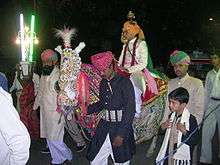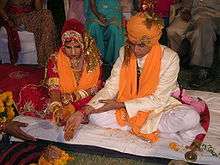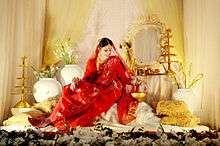South Asian wedding photography

South Asian wedding photography refers to wedding photography of activities relating to Indian, Pakistani[1] and other South Asian weddings.
Indian weddings are a Rs. 800 billion industry, which is expected to grow by 25% per annum,[2] with a significant part dedicated to photography.
Indian weddings are significantly different from western marriages. While the western marriage rituals have become common in many countries, they have not become common in India except among the Christians. Indian weddings use bold colors, not white. Loud music is considered to be proper during parts of an Indian marriage. The ceremonies are elaborate and can take considerable time even when condensed. There are various rituals like Seven Promises of Indian Marriage which are called as 'Saat Pheras[3]' and are performed on the day of wedding. An Indian marriage is traditionally a public affair, with the bridegroom taken in a procession through the town. Even a modest Indian wedding can have several hundred participants, who are all thought to be "relatives and close family friends".[4] By convention a photographer is required to include each guest in at least one photograph which includes the bride and the groom. These factors make photographing an Indian wedding significantly different from western weddings.

Wedding photography is a now a major commercial endeavor in India that supports the bulk of the efforts for many photographers. There are photographers outside of India that specialize in Indian weddings.
Bright colors such as red and orange are considered appropriate,[5] and the photographs often use saturated colors.[6] Generally Indian wedding proceedings do not pause for photographs, requiring the photographers to anticipate the next event and be ready with the right angle.
Photographs from some famous Indian weddings have been published widely in newspapers:
Lavish marriages are often portrayed in Bollywood movies.
Photographed moments


Common moments that are recorded in Indian wedding photography include:[8]
- Mehendi (henna) on the palms of the bride indicating she is getting ready
- The bride in a wedding dress with heavy wedding jewellery.
- Arrival of the groom on a horse in a procession, and being greeted at the door.
- The wedding mandap
- Bride and groom seated and engaged in worship.
- Bride and groom walking around the sacred fire.
- Special moments such as
- tying the knot
- holding hands
- tying the mangalasutra
- filling the parting of the hair with sindoor
- Portrait of the couple as a royal couple, with guests on their sides as blessing dignitaries or attendants.
- Bidaai, the crying of the bride as she leaves her father's home
- Wedding portrait: showing the newly wedded husband and wife.
India's "wedding season"

In India, a number of weddings take place in the "wedding season". For example, in early October, the city of Delhi can have up about 15,000 weddings a night.[9] That can make it hard to locate wedding photographers for those who have not planned sufficiently in advance.[10] Wedding planning in India is now a $10 billion market.
Indian wedding photography overseas
Indian children, who have been raised overseas, also expect to get married in the Indian tradition.[11]
Photo stories of Indian weddings occasionally are published in US newspapers.[12]
Technical and cultural challenges
Indian wedding photographers need to aware of the cultural aspects of Indian wedding photography. They need to understand the symbolism of specific religious rituals and perhaps meet with in-laws to ask whether traditional photo compositions are desired.[13] They also need to take into account the variation in skin tones.
India has a new breed of wedding photographers who capture candid and journalistic wedding photographs. NRI (Non-resident Indian) people who come to India for marriage tend to look for Indian photographers on the web.
Indian wedding events can often take multiple days, and may take place in multiple locations. Mehendi/Sangeet can often take place at bride's home, whereas the wedding is held at a hotel or function hall.
See also
References
- ↑ Ansari, Noman; Aamir, Sama (8 December 2013). "Wedding photography: Framed for life". The Express Tribune. Retrieved 8 December 2013.
- ↑ "Taking the Indian wedding global". Business Line. Retrieved 7 June 2015.
- ↑ "Saat Pheras". Indian Wedding Photography. October 8, 2015. Retrieved October 8, 2015.
- ↑ Singh, Madhur (16 August 2007). "The Big Fat Indian Wedding Grows Bigger and Fatter". Time (magazine). Retrieved 7 June 2015.
- ↑ Mangan, John (23 March 2009). "Wedding of the week - Melbourne". The Age. Retrieved 7 June 2015.
- ↑ Vivah - Design a Perfect Hindu Wedding by Meenal Atul Pandya
- ↑ Roy, Amit (2 June 2004). "£30m wedding bill as Bollywood comes to France". London: The Daily Telegraph. Retrieved 7 June 2015.
- ↑ Rituals & Customs of a Hindu Wedding: Design & Planning Guide by Kavita Kapoor
- ↑ Perry, Alex (2006-02-19). "Letter From New Delhi: Land of the Wedding Planners". Time.com. Retrieved 2015-06-12.
- ↑ "Matches, hatches and dispatches are all made in heaven for India's millions". The Guardian. Retrieved 7 June 2015.
- ↑ "Tradition! | UTSanDiego.com". Signonsandiego.com. 2009-06-07. Retrieved 2015-06-12.
- ↑ "Photo Galleries | UTSanDiego.com". Albums.signonsandiego.com. 2015-06-08. Retrieved 2015-06-12.
- ↑ Archived February 18, 2009, at the Wayback Machine.